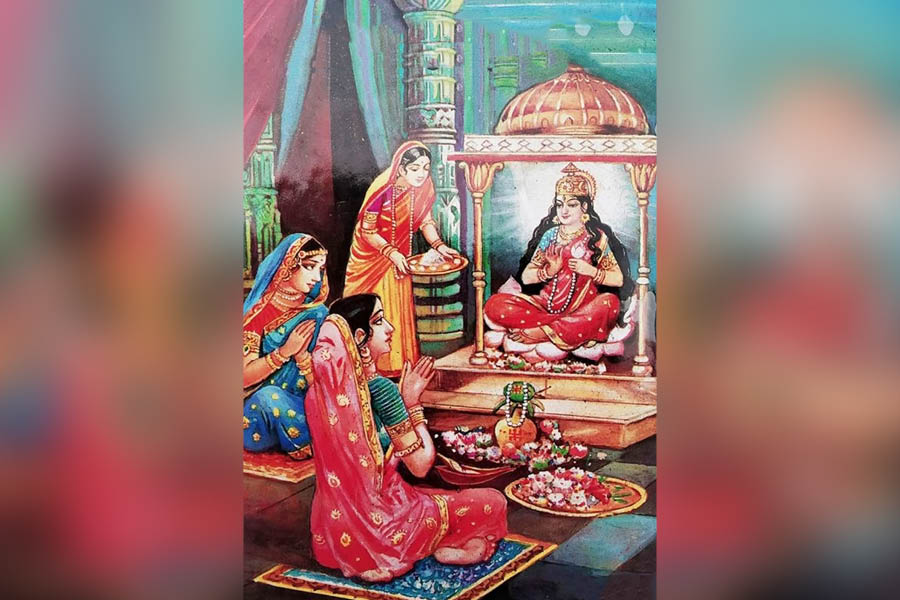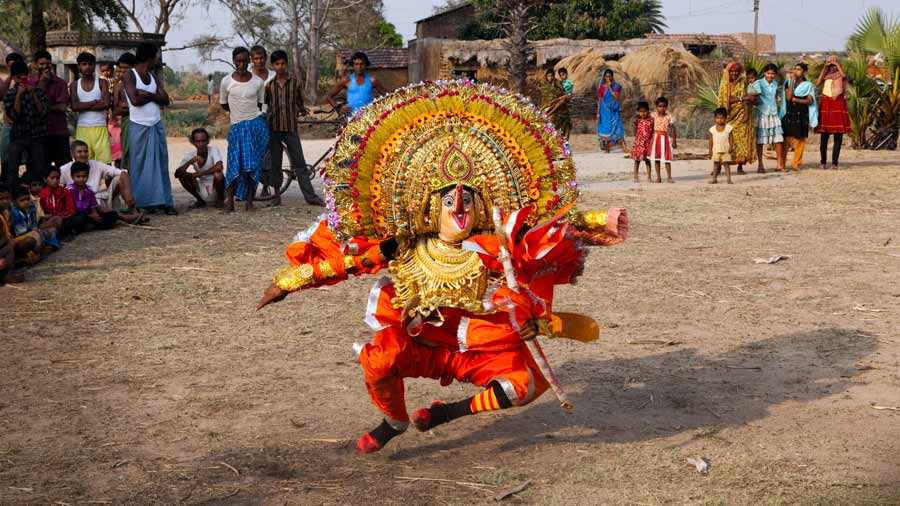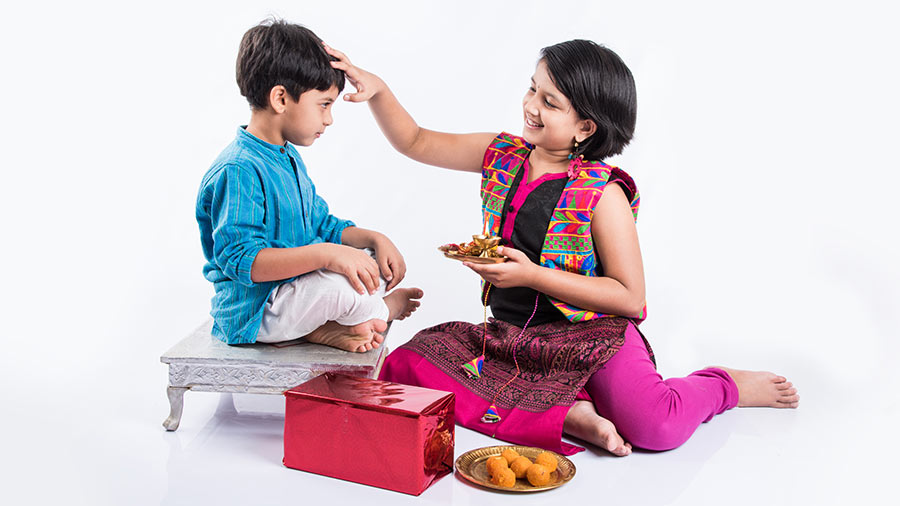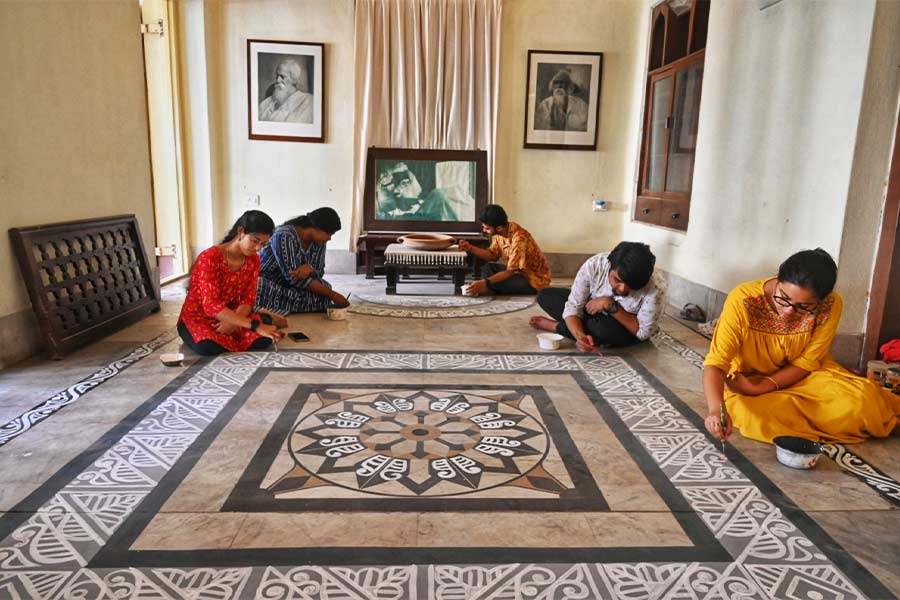Baro mashe tero parbon (13 festivals in 12 months) is how the saying goes in Bengal, thanks to the region’s full calendar of festivals and celebrations throughout the year. Besides the bigger and more well-known festivals, every month in the Bengali calendar has a special day or two dedicated to smaller celebrations — devoted to prayers and rituals for the wellbeing of the family and near and dear ones. These are often known as brotos, which loosely translates to vow.
Abanindranath Tagore, in his book Banglar Broto, classifies broto into three types — those involving holy rites, brotos performed by women and those performed by spinsters. Brotos are usually performed by groups by women for the welfare of the entire family — those in her maternal home and in-laws.
The rituals associated with these pujas often vary across regions. Most of them have a unique story attached to them and the narration of a brotokotha is an integral part of the festivities. Some of the brotos also have short rhymes attached to them, and are often based on seasons. The festivals are not extravagant, but rather homely rituals — there is no specific time of the day mentioned for these rituals, nor is a purohit involved. The rituals are most often performed using simple easily available things like tulsi leaves, belpata, seasonal flowers and earth.
One of the forms of a broto is a Sashti Puja. Professor Barun Chakraborty, retired head of the folklore department of Kalyani University and Emeritus fellow of Rabindra Bharati University, said brotos are performed by the women for the wellbeing of the whole family while Sashthi Puja is performed for the wellbeing of children and also for motherhood. “Sashthi puja is also a broto. The brotos are performed for the wellbeing of the whole family. Since most of them are performed by women, they do it for both families. The brotokotha are folktales that tell you about the history of the broto. The language is lucid Bengali and the rituals are performed by the women themselves. The articles required are also very simple, something which women did not have to buy. The rituals end with brotokotha where one particular woman reads out the brotokotha to all other women taking the vow. ”
Purni Pukur o Harir Charan Puja
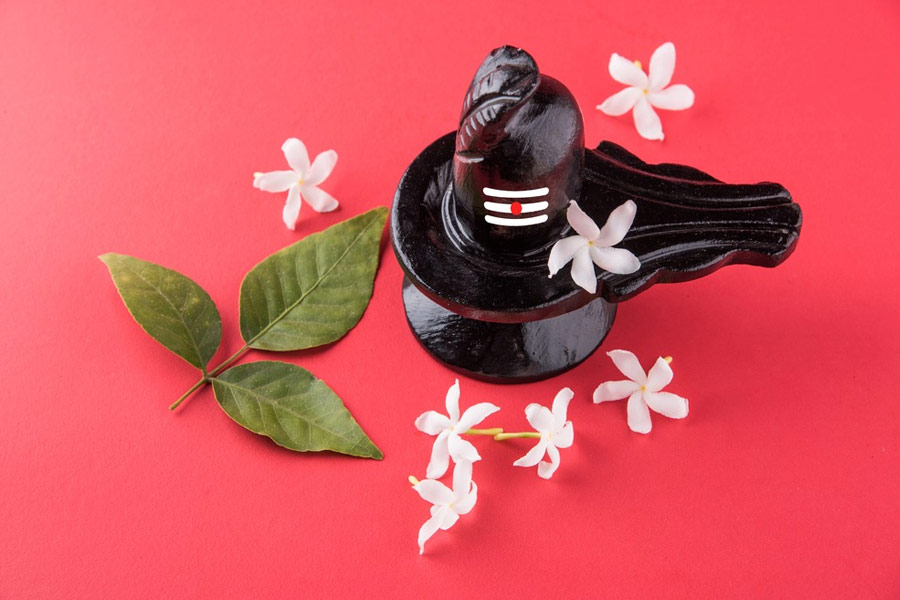
Stems and leaves of bel (woodapple) are planted in a pukur for this broto
ShutterstockThis vow is observed in Baisakh, the first month of the Bengali calendar. Devotees pray not only for the welfare of the family but for protection against the beatings of the season — ponds don’t dry up in the scorching weather and trees do not succumb to the heat. A little burrow signifying a pond or pukur is made and filled with water. Stems of bel (woodapple) are planted in the pukur and decorated with garlands, while flowers are sprinkled along the sides of the pond.
Though this broto does not have any story related to it, there are some poems narrating the broto. “Purnipukurpushpamala\Ke puje re dupurbela?\ Aami sati Leelabati bhaier bon putroboti\Hoe putro morbe na\ prithibite dhorbe na.”
Another puja in the month of Baisakh, usually observed on a Tuesday or Saturday, is Joshoi Puja. The rituals are performed under a kul tree (jujube tree) or bel gaach (woodapple tree). There’s no idol involved, and two kinds of offerings are made — joshoi guro made from gom (wheat), job (barley), chhola (Bengal gram), til (sesame), chaal (rice), chire (flattened rice) and matar (white peas); as well as a mix of of atop chaal (husked rice), milk, ginger, sesame and aankher gur (sugarcane jaggery) ground in a traditional dheki or husking machine. These offerings are known as joshoi- er khasha. The puja, performed to keep family and friends protected, is very popular in the Rajshahi area of Bangladesh.
Bata Sashthir Kotha
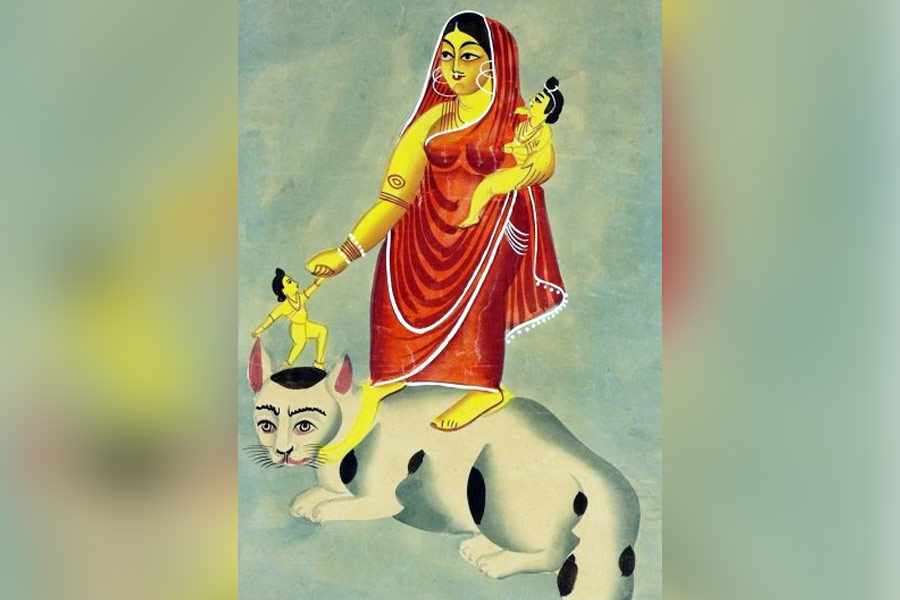
A depiction of Maa Sashthi
Wikimedia CommonsThe legend goes that there was once a trader’s wife who would steal milk and fish and blame it on a cat. The upset cat went to Ma Sashthi for guidance and the angry goddess hatched a plan. The trader’s wife gave birth to seven sons but all of them were stolen after birth while the mother was asleep. After giving birth to her eighth child, she did not sleep, only pretended to. On the third day after the birth, she saw a black cat taking her child away, and followed the cat. It led her to a forest where she saw an old woman under a tree, and some small boys playing around her. The trader’s wife went up to the old woman and asked her why the cat had taken her baby. The old woman reminded the trader’s wife how she had stolen milk and fish and blamed the cat. The mother then realised that the old woman was, in fact, Ma Sashthi and pleaded for her forgiveness. The goddess returned her child but said his life would be filled with obstacles that may even lead to his death. However, she also gave remedies to the problems. The woman followed everything Ma Sashthi had told her to protect the child and thus popularised Sashthi Puja. Mothers observe Bata Sashthi in the month of Jaishtha (May-June) to pray for the wellbeing and protection of their children. This is also called Botsabitri Broto.
Loton or Lonthon Sashtir Kotha
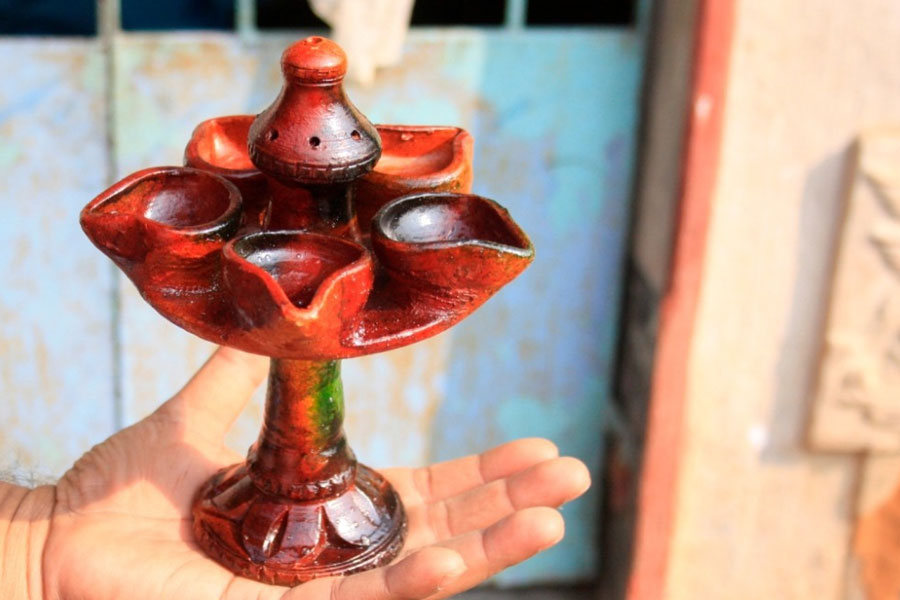
Lonthon Sashti is celebrated in Shravan (July-August)
ABP archivesWith Shravan (July-August) comes another Sashthi puja. The story of Lonthon Sashti begins with a Brahmin who made a pigeon of gold. Every year during Sashthi puja, his wife would take out the gold bird and hand it over to him for puja. After a few years, the pigeon went missing. Chaos followed as the Brahmin’s wife and sister quarrelled, blaming each other. The next day both their children were dead. Upset, the Brahmin’s wife went in search of Ma Sashthi for guidance. Sashthi Buri asked the woman to go and sit by the river and wait for two boats — the first stood for truth and the second for sins — and that the second would give her answers. The woman waited as the first boat sailed by, and then the boatsman of the second boat asked the women to buy flowers and fruits, but not to pay the shopkeepers directly. Instead she had to ask them to collect the money from her home, but when they turned up, she would have to drive them away without paying them and then offer those fruits and flowers for Sashthi Puja. The woman followed the instructions and after the puja, she sprinkled holy water on the dead children and they were alive again. Also called Loton Sashti, the festivities also include eating ridge gourd, ghee and sugarcane jaggery.
Bhadra Masher Lokkhir Kotha
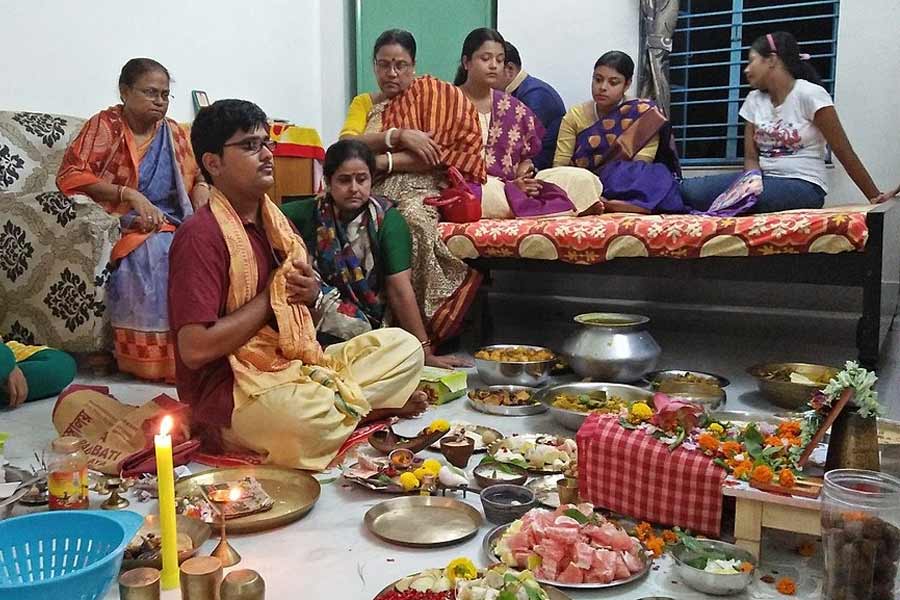
Lakshmi Puja is celebrated in multiple months throughout the year in Bengali households
Wikimedia CommonsWe know of Kojagari Lakshmi Puja that comes after Durga Puja or Dipanwita Lakshmi Puja that is held on the day of Kali Puja or even the Lakshmi Puja done at home by married women every Thursday. In Bengal, the goddess of wealth and prosperity is worshipped in the month of Bhadra (August-September).
The story of this Lakshmi Puja involves a poor Brahmin whose son would beg for alms to sustain his family. One day no one gave him money as it was Lakshmi Puja, and people said that if they gave away money, the goddess would walk away from them too. They also told him that Lakshmi always took care of her devotees and as long as she stayed with them there was no dearth of money or food. So, the boy went to the jungle in search of Mahalakshmi. In the middle of the jungle, he saw a tree with an owl — Lakshmi’s consort — and started to pray, but the owl refused to deliver his message. Only after the son had saved money for three days and fed the bird banana, milk and curd did it go to Mahalakshmi and pleaded with her to go to the Brahmin’s home. Even then the goddess was reluctant because the house they stayed in was not clean. After much persuasion, Lakshmi agreed to go but did not stay for long as the house was unclean. The Brahmin’s son then cleaned the house himself, drew an alpona on the floor, and lit some incense sticks, which impressed the goddess and she stayed there. The boy and his mother soon earned a lot of wealth. The puja is observed by immersing pituli (rice flour) dolls in the river, and with mothers tying bananas in the anchal of their saris, and listening to the brotokotha, while sitting with their kids on their laps.
The belief is that people who worship Ma Lakshmi in the months of Chaitra (March-April), Poush (December-January) and Bhadra never have any shortage of food and clothes.
Durga Sashthir Kotha

Durga Sashthi is part of Durga Puja
ShutterstockAshwin is an important month in the Bengali calendar as the biggest festival of Bengalis, Durga Puja, falls in this month. Durga Sashthi is a part of the festival. There lived a king who had a lot of wealth but no children. The king and the queen were both sad about it. One day a potter's wife came to the palace to sell pottery. The queen liked the sari that she was wearing. On asking, the potter’s wife said it was a khamchi sari. She went away but the queen was very sad as she did not have such a sari. The king tried to get one for the queen but in vain. Then the potter’s wife told the queen the secret behind the khamchi sari — her children often came and rubbed their soiled hands in the sari and thus the ‘designs’ on it. She also suggested the queen observe Durga Sashthi to pray for children. The queen did and soon gave birth to a son. The main festivities of Durga Puja start with Sasthi. Usually the women of the house pray to Ma Sashthi for the wellbeing of their children. The women abstain from eating any non-vegetarian food on this day. It is a ritual in most homes to wear new clothes on this day.
Jom Pukurer Kotha
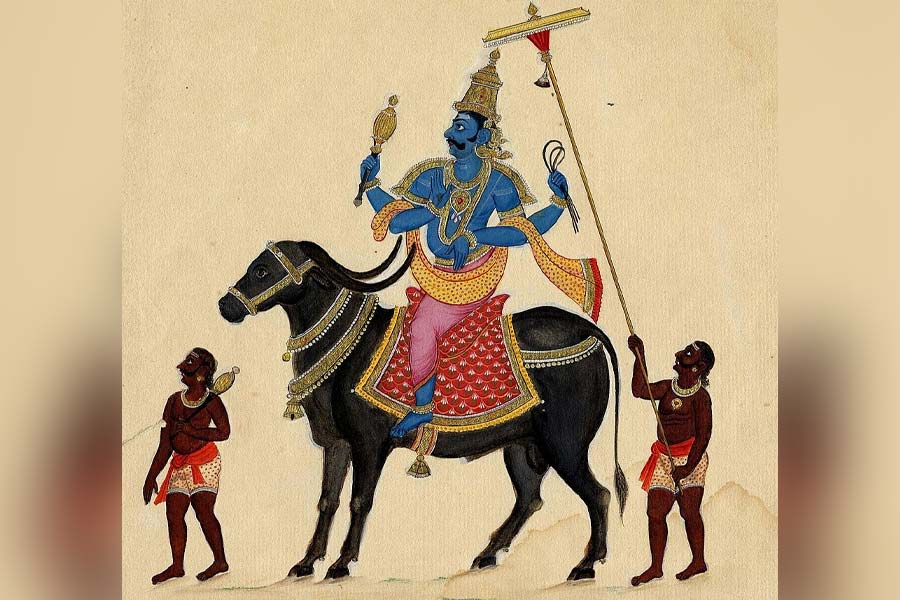
A depiction of Jom (Yamraj)
Wikimedia CommonsThe story of this festival celebrated in the month of Kartik (October-November) is set in a village, where a woman named Udhbera lived with her son and a daughter named Jaya. One day, while going for a holy dip in the Ganga, the mother instructed the daughter to not give anything from the house to anyone. However, once the mother left, people kept coming to the house asking for things and Jaya gave away everything. On returning home, Udhbera was very angry and vowed to get her daughter married to the first person she saw the next morning. Dharmaraj, the god of justice, came to their home in disguise the next morning and sat in front of their door. At first, the mother did not want to get her daughter married but she had to keep her vow. Soon after, her son was married as well. One day, Udhbera’s daughter-in-law saw some women of the village praying, and on asking them found out that they were observing Jom Pukur Broto for the welfare of their near and dear ones. On hearing this, she too started to make a small pukur to worship. Someone gave her a paddy tree, someone gave a turmeric tree and soon she had all that was needed for the puja. However, when Udhbera found out about this, she destroyed everything. For four years, whenever the daughter-in-law made the jom pukur, Udhbera would destroy it. The daughter-in-law gave up and Udhbera died a few days later. At that time Jom (Yamraj) came to punish her for her deeds, but Jaya came to know of this and pleaded to her husband for mercy. Dharmaraj said only if the daughter-in-law put up a pond in her name would Udhbera be pardoned. The daughter went and persuaded the daughter-in-law and she made two ponds — one for Jom and the other for the mother-in-law. As soon as she did this, Udhbera was sent to heaven.
Kuli Mangalbarer Kotha

Maa Mangalchandi Temple, Amarpur
@tripura_glow/TwitterObserved in the month of Agrahayan (November-December), the story of this broto begins with the family of a trader who has seven sons and daughters-in-law but no daughter. One day the whole family went to visit a friend and saw a puja being held. On enquiring, the wife came to know about a broto being observed for good fortune, protection from danger, and for fulfilling wishes. The name of the puja was Kuli Mongolbar Puja. After returning home, the trader’s family performed the puja and a daughter was born, much to everyone’s joy. She was named Kulonandini.
A few days later, the trader’s wife passed away, handing over the responsibility of her daughter to her friend. Soon after, the trader went off to trade with his sons. Kulonandini grew up to marriageable age but the family seemed not to care about her wedding. The mother’s friend asked Kulonandini to observe Kuli Mongolbar Puja. When her father and brothers returned, they arranged for her marriage. On the day of marriage, Kulonandini was asked to fast, worship in the morning and have doi murki makha (curd and puffed rice) made by her mother’s friend at midnight. When she was about to eat at midnight, her husband woke up and saw her. She told him about the broto, observed in reverence of Ma Mangalchandi. The husband took different kinds of tests to test the effects of the broto and the story goes that Ma Mangalchandi helped out her devotee during every danger. Kulonandini even brought her husband back from the dead with her worship. After the husband woke up he declared the broto is to be observed by every woman, even unmarried ones.
This puja is performed on the Tuesday that falls on Shuklopakshya every Agrahayan. Women decorate the floor of their homes with alpona, a kul (jujube) branch is planted in a pot, and an offering of two Jujube fruits, two bananas, chire, gur and sweets is made to the goddess.
Sukhi Dukhir Kotha

Sukhi Dukhir Kotha is Broto Kotha for Lakshmi Puja in the month of Poush
The Lakshmi Puja observed in the Bengali month of Poush involves the story of two sisters — Sukhi and Dukhi. Sukhi was rich but Dukhi was so poor that she had to beg for her livelihood. A time came when Dukhi’s children were all starving and she needed help. She first went to her brother’s place but was turned away by her sister-in-law. Dukhi then went to Sukhi and told her sister about her plight. Sukhi said she would give her some khuder chaal (fragmented rice) if her sister could take out pests from her hair. It took Dukhi almost the entire day to accomplish the task and she was given the rice. As Dukhi was on her way home with the khuder chal when a servant from Sukhi’s family confronted her and said she had failed in her task — a pest had remained in Sukhi’s hair. He took away the rice from a helpless Dukhi. On her way home, Dukhi saw a snake and at her wit’s end, she caught it, cut it into pieces and put it to boil. Soon, gold coins emerged from the snake. From that day onwards, Dukhi had no worries. On hearing about Dukhi’s turn of fate, Sukhi invited Dukhi and her family to her home. They visited but no one ate anything there. Dukhi took some food from each plate and threw it in the name of her wealth, making Sukhi realise her mistake. Dukhi started to propagate worshipping Lakshmi in the month of Poush.
An alpona is an intrinsic part of this puja as is the offering of a dhaaner chhora (a panicle of rice).
Dakhindar Puja
Performed in the winter month of Magh (January-February), this puja does not involve the worship of an idol. The story goes that there was once a king who had a daughter named Padmabati. One day, the king asked everyone in the kingdom the question, ‘by whose grace do you eat’. Everyone except his daughter said it was by the king’s grace, while Padmabati attributed it to her own good fortune. The king was disappointed and got her married to the first person he saw the next day — a woodcutter. The couple were sent off to the jungle and they earned their livelihood by cutting and selling wood.
One day, as the couple went about their work they heard prayer bells. On enquiring, her husband learned the puja was to worship Dakhindar, to protect people from wild animals and dacoits in the jungle. On reaching home, Padmabati asked her husband to bring some balls of sweet curd, flattened rice and banana to offer to the deity. The woodcutter went to bring the prasad and on his way back tried to eat some but everything seemed very hard, so he threw them away. On reaching home, he confided in Padmabati. The two went to the place where the puja was being held and Padmabati collected all the balls that her husband had thrown away as prasad, and discovered that they were all balls made of gold. Using the gold, they set up an empire and named it Kathure Padmabati Nagar.
On the other hand, Padmabati’s father, by the grace of goddess Lakshmi, has started missing his daughter and set out in search of them. When the father and daughter met, the king repented how he had ill treated his daughter and offered to take them back to his palace but Padmabati did not go. Instead, she asked her father to worship and propagate Dakhindar Puja.
Ashok Sashthi

On Ashok Sashthi, curd is mixed with moong kalai (black moong) and flowers of the ashok tree and eaten
ShutterstockThis Sashthi is observed in the month of Chaitra (March-April), the last month of the Bengali calendar. The story of this broto revolves around a childless king named Ashok. After a long wait, a daughter was born to the king after the queen did the broto of Ashok Sashthi. The king named her Ashuki. One day, after a long walk, Ashuki sat gossiping with her friends under a tree in the woods. They spoke about things like how one of them could feed the entire world with a potful of rice, another said she could quench the thirst of the whole world with a glass of water and again fill it up. Ashuki said that she could give birth to seven children at a time. A king overheard Ashuki’s words and went to meet her father, king Ashok. He told Ashok that he didn’t have any children and hence wanted to marry Ashuki. The two got married and Osukhi became pregnant. But at the time of delivery, the seven other queens of the king tricked Ashuki by tying seven layers of cloth over her eyes. She gave birth to six boys and a girl, but she was told she had given birth to seven wooden dolls. The seven queens put the babies inside a basket and sailed them in the river. The king, on hearing about the dolls, banished Ashuki.
At the other end, king Ashoka, who had become a sanyasi after Ashuki’s marriage, was bathing by the river when he found the basket with the babies. With his eternal powers, he realised they are his grandchildren. He took them in and raised them. Some time later, one day seven queens arrived to bathe in the river. King Ashok gave the children a wooden horse each and asked them to take the horses near the river to drink water. On seeing the kids with their wooden horses, the queens started to laugh, and asked them how wooden dolls could drink water. The children, as taught by Ashok, replied with a question, ‘how could a queen give birth to seven dolls?’ The queens understood who the children were and plotted to kill them. The children were invited for a meal to the palace. The girl asked for water and told the king that she would only drink water from the hands of the queen he had banished. Ashuki came and gave water to the girl, while the boys ate the food and died of poisoning. King Ashoka went to the palace and told the king everything. The dead sons were then brought back alive by sprinkling holy water. The king had the seven queens imprisoned and brought Ashuki back to the palace. From that day, the king ordered that Ashok Sashthi be celebrated to protect children from all kinds of harm.
On this day, curd is mixed with moong kalai (black moong) and flowers of the ashok tree and eaten.


